Lesbians are well-known for our unique ability to find a girlfriend and then turn that romantic relationship into an all-consuming life partnership — starting businesses, pursuing activism, revolutionizing social services, erecting schools, liberating marginalized groups. This is true today but has also been true since the beginning of time. Back in the day, many women were held back from activism and entrepreneurship by the demands of marriage and motherhood, making some women-loving-women uniquely able to pursue civilization-shifting ventures. (Although many managed to do both!) We’re gonna talk about some of those relationships here today.
For the purposes of this list, I defined “power couple” as a relationship through which both women were able to achieve greater professional, artistic or service-related success because of their relationship with each other. I leaned towards couples that actually made or did things together — whether that be starting a school, hosting a nightclub, creating social services for disadvantaged humans or making films. Also, as usual, the word “lesbian” is used as an adjective to describe a same-sex relationship, not the sexual orientation of the women in the relationship.
Sources include Elisa Rolle’s Days of Love: Celebrating LGBT History One Story at a Time, Lilian Faderman’s To Believe in Women: What Lesbians Have Done For America – A History and Christina Anne Wooner’s incredible thesis I stayed up late reading last night, “The Famous Lady Lovers: African American Women and Same-Sex Desire from Reconstruction to World War II.” Most other sources are linked within the post. I found a lot of contradictory information throughout my research so I imagine many of you will have some of your own!
For this installment, I’m focusing on couples who began their courtship prior to 1940. Future installments will obviously be more racially diverse as we move into eras where non-white people had more access to “power” and also more recorded histories.
16 Lesbian Power Couples, 1830s – 1940s
Rebecca Perot and Minister Rebecca Cox Jackson (1830s-1871)
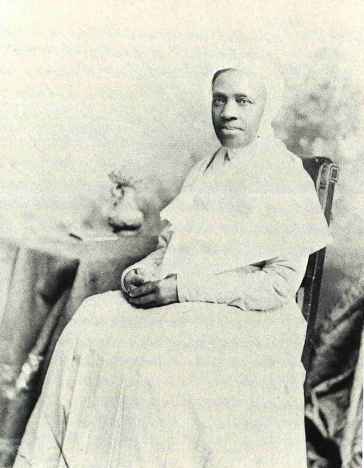
Rebecca Perot, aka Rebecca Jackson (There are no known pictures of Rebecca Cox Jackson) via shaker museum sketchbook
Rebecca Cox Jackson was raised in an African Methodist Episcopal family but, following a spiritual vision that put the voice of the divine within her, she broke off from the patriarchal church to start her own thing. Her success as a preacher led to her divorce, which led to her traveling around Pennsylvania and New England sharing her gifts, eventually falling for the community she found within a woman-led group of Shakers. She became a Shaker minister and met Rebecca Perot, with whom she joined a sect of the Watervliet Shakers. Eventually the two women — whose “mystical visions” had feminist and homoerotic undertones and often featured the other in divine contexts — decided they’d had it with white people and started their own family of black Shakers in Philadelphia, combining black female praying band traditions with Shaker theology. When Jackson died in 1871, Perot re-named herself “Mother Rebecca Jackson Jr” and took over the Philadelphia family.
Sallie Holley and Caroline Putnam (1848 – 1893)
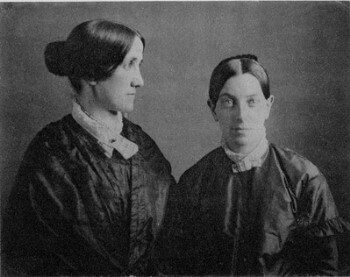
photo via civil war women
Sallie and Caroline met at good ol’ Oberlin College, and the noted “anti-slavery team” became agents of the American Anti-Slavery Society immediately after graduation. They traveled on the abolitionist lecture circuit, often along with the legendary Sojourner Truth. After the Civil War, Sallie stayed up North giving talks, raising money to educate freed slaves in the South, and Putnam went to Virginia to teach freed slaves, eventually starting The Holley School, which became America’s first settlement house. Sallie then joined Caroline in Lottsburg, where they integrated themselves with the community, operated their school year-round and unlike some future suffragettes, were dedicated to enabling, preserving and protecting the right of Black men to vote even when white women could not yet do so. Sallie died in 1893 and Caroline in 1917, at which point the school was deeded to an all-Black board of trustees and continued operating for decades.
Harriet E. Giles and Sophia B. Packard (1855-1891)
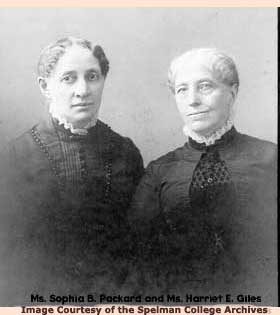
image via keeping & creating american communities
Giles met Packard in in the mid-1850s when Giles was a student at the New Salem Academy in New Salem, Massachusetts, and Packard was the preceptor. They hit it off right away, and shortly thereafter shuttled off to Atlanta to start a school for Black women who had been newly released from slavery. Packard was the first president of the school, then known as the Atlanta Baptist Female Seminary and now known as Spelman College, when it opened its doors in 1888. Giles took over after Packard’s death in 1891. The two women are now buried next to each other in Silver Lake Cemetery.
Ellen Gates Starr & Jane Addams (1877-1892)
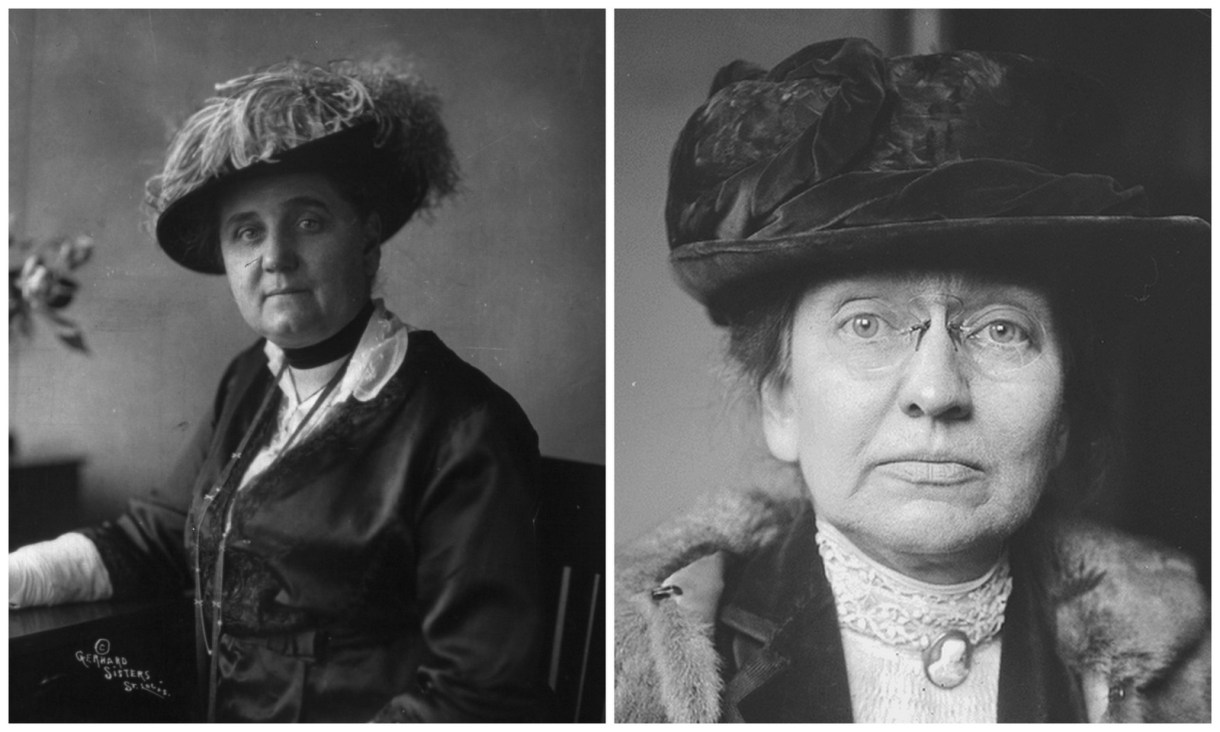
Ellen Gates Starr met Jane Addams at the Rockford Female Seminary in 1877, and it was through their relationship that Addams got the confidence to embark on the GROUNDBREAKING AND INFLUENTIAL Hull House Project in Chicago. The Hull House was part of a movement to provide social and educational opportunities for working class women, mostly recent immigrants; offering classes in literature and history, hosting public concerts, providing child care and putting on free lectures. The two women taught classes, served as on-call midwives, sheltered victims of domestic violence, and advocated for legislative reforms that are now seen as the first models for “social welfare.” Ellen was far more religious than Jane, which may have played a role in their eventual breakup. Jane subsequently moved right along, in classic lesbian fashion, to Mary Rozet Smith, the daughter of a wealthy Chicago industrialist, who was very helpful to Addams’ various missions through other means.
Edith Anna Somerville & Violet Florence Martin (1887-1915)
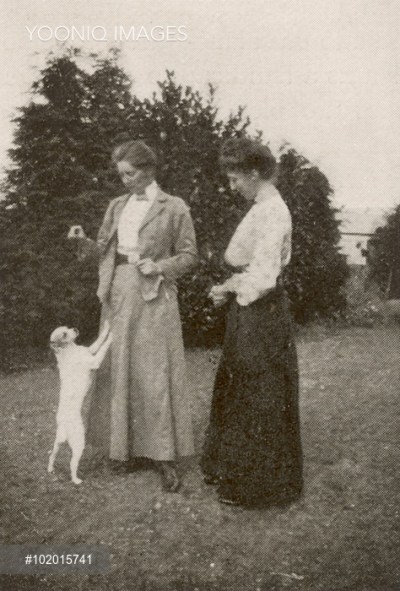
Edith, an Irish novelist and her cousin/girlfriend (listen it was a different time), Violet, co-wrote fourteen stories and novels under the name “Martin Ross.” Their most popular titles were The Real Charlotte and The Experiences of Irish R.M.. After Violet’s death, Edith was inconsolable, and decided to keep writing as Martin Ross, convinced the two were communicating through spiritualist séances, which I personally feel is totally legit.
Ethel Mars & Maud Hunt Squire (1894-1954)
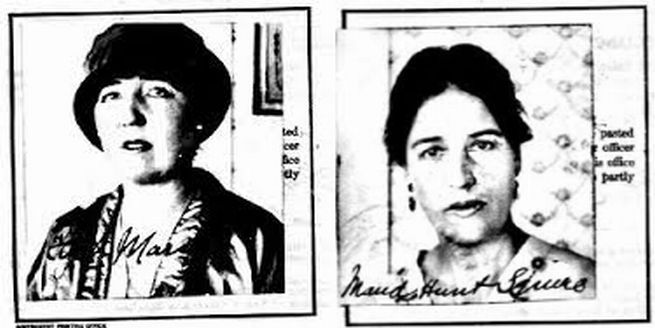
image via pinterest
These two American artists met at the Cincinnati Art Academy in the 1890s and stayed together for 60 years, living for patches in France and in Provincetown, Massachusetts. Maud was known for her book illustrations and color etchings, Ethel for her painting, color woodblock prints and drawings. They collaborated on projects like illustrating the legendary Child’s Garden of Verses. The couple were regulars at Gertrude Stein’s salon in France (and the subject of her word portrait Miss Furr and Miss Skeene). Also, The New York Times says they “loved to behave outrageously.”
Mabel Reed & Mary Ellicott Arnold (1894-1963)
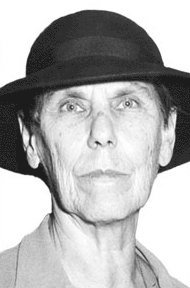
Mary Ellicott Arnold, via wikipedia
Mabel and Mary were together for around 69 years, having met as children in New Jersey, and went on to be prominent urban organizers, philanthropists and social activists. After five years of middling success farming a 50-acre plot, they put in time at the City and Suburban Homes Company, which provided housing solutions for the working poor. They were then positioned as “field matrons” at the Hoopa Valley Indian Reservation, where they defied pressure to enforce white cultural values upon the Natives who lived there, and wrote the book In the Land of the Grasshopper Song. Later organizing projects included cooperative cafeterias and apartments in New York, credit unions for lobster fisherman and cooperative housing projects for coal miners, as well as many other housing projects throughout the Northeast. They became widely regarded social activists and organizers, known for their drive to include women in their husband’s housing decisions and unconcerned by critics of their unconventional behavior — wearing divided skirts, riding horses through the backwoods, living in non-white areas, and thwarting conventional Victorian female ideals.
Fannie Johnston & Mattie Edwards Hewitt (1901-1917)
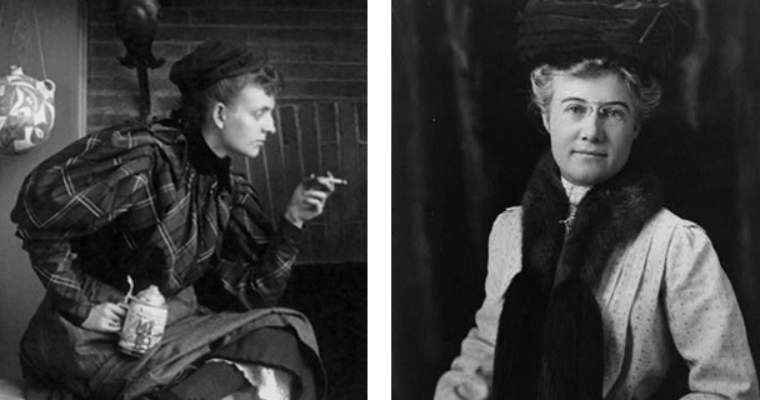
These two photographers met at the 1901 Pan American Exposition in Buffalo. Johnston was a pioneer in her field as one of the most successful female photographers in America, snagging cool gigs like shooting Edith Wharton’s Paris-adjacent villa, Booker T Washington’s face and Alice Roosevelt’s wedding. Hewitt was then working as an assistant to her husband, also a photographer, who she officially divorced in 1909. Thus, after eight years of an intense epistolary long-distance love affair with Fannie, Mattie U-Hauled with Fannie in New York, eventually opening an architectural photography studio together. Like so many great power lesbian couples, Mattie’s admiration of Fannie’s work was instrumental in what drew them together. They were commissioned to photograph buildings like the Cathedral of St. John the Divine and the Hotel Manhattan. Then in 1917 they had a huge blowout fight and broke up forever.
Gertrude Stein & Alice B. Toklas (1907-1946)
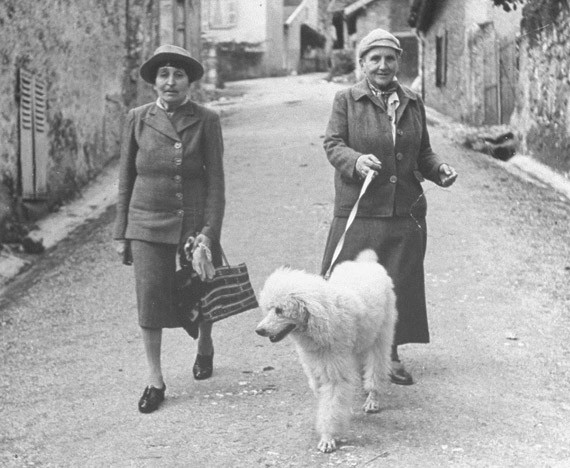
One of the most revered lesbian couples of all time, Gertrude Stein was an American novelist, playwright and poet with an unconventional style and a Modernist art collector. She met Alice B. Toklas, who would serve as her “confidante, lover, cook, secretary, muse, editor, critic and general organizer,” the day Toklas arrived in Paris. Stein fell hard and fast for Toklas, and by 1910 they were hosting a salon in their home on 27 rue de Fleurus that is now known as one of the most influential gathering spots in the history of arts, literature and queerdom. Guests included Pablo Picasso, Ernest Hemmingway, F. Scott Fitzgerald, James Joyce, Thornton Wilder, Sherwood Anderson, Henri Matisse, Ethel Mars, Maud Hunt-Squire, Eleonara Sears, Eva Le Galienne and Francis Cyril Rose. Toklas hosted the wives and the girlfriends and Stein handled the men. The duo hit the big time with the mass market publication of The Autobiography of Alice B. Toklas in 1933, which led to an extended U.S. lecture tour. Toklas and Stein were together until Stein’s death in 1946.
Frances Witherspoon & Tracy D. Mygatt (1908-1973)
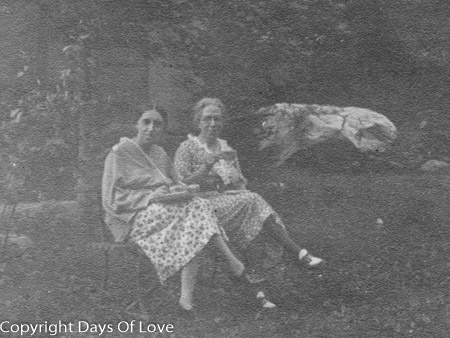
via Days of Lore
Frances and Tracy both graduated from Bryn Mawr in 1908, and then committed themselves entirely to the causes that mattered to them: world peace, pacifism, women’s rights and civil rights. But pacifism was always their number one passion. During World War I, they advocated for conscientious objectors: Tracy helped organize the Anti-Enlistment League and Frances founded America’s first-ever organization to support the rights of objectors as well as those persecuted for free speech, the Bureau of Legal Advice. The BLA is considered the forerunner of the American Civil Liberties Union, which was founded shortly thereafter, and which worked in tandem with the BLA towards common causes. They joined the Socialist Party in New York upon moving there in 1913, and helped organize shelters and food distribution programs in churches for the homeless. They were inseparable for 65 years, even dying within weeks of each other, which everybody knows is the ultimate lesbian love act.
Ethel Collins Dunham & Martha May Eliot (1910-1969)
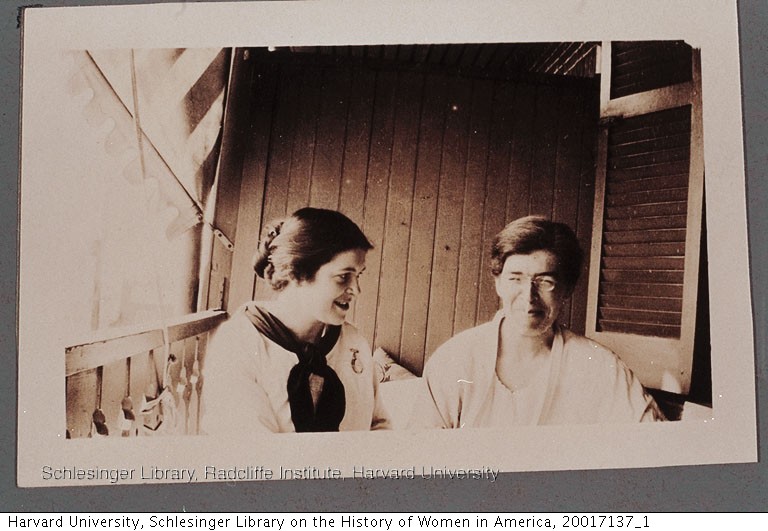
Martha was a headstrong and stubborn young woman from the jump, refusing to marry and insisting on a life of travel and learning. She met Ethel, who’d felt uninspired by the socialite lifestyle she’d been living, at Bryn Mawr, and the two decided to attend medical school together, become doctors together, and live together forever and ever. AND THEY DID. They got their medical degrees from Johns Hopkins, where they were active in the local suffrage movement, but were then separated by subsequent work placements. Eventually they were reunited at the brand-new department of Pediatrics at the Yale hospital in New Haven. Martha undertook a study of rickets amongst low-income children, which launched her career in community pediatrics and then got her a gig as director of the Child Hygiene Department of the Children’s Bureau, around the same time that Ethel became one of the first female professors at Yale’s School of Medicine. Their ambitions, extensive research accomplishments and subsequent appointments — including President Truman naming Martha chief of the Children’s Bureau and Ethel becoming the first female member of the American Pediatric Society — often meant spending a lot of time apart, but as Faderman wrote in To Believe in Women, “they seem to have believed that their relationship gave them sustenance for the challenges and that their work and their life together were inextricably connected.”
Ethel Williams & Ethel Waters (1910s-1920s)
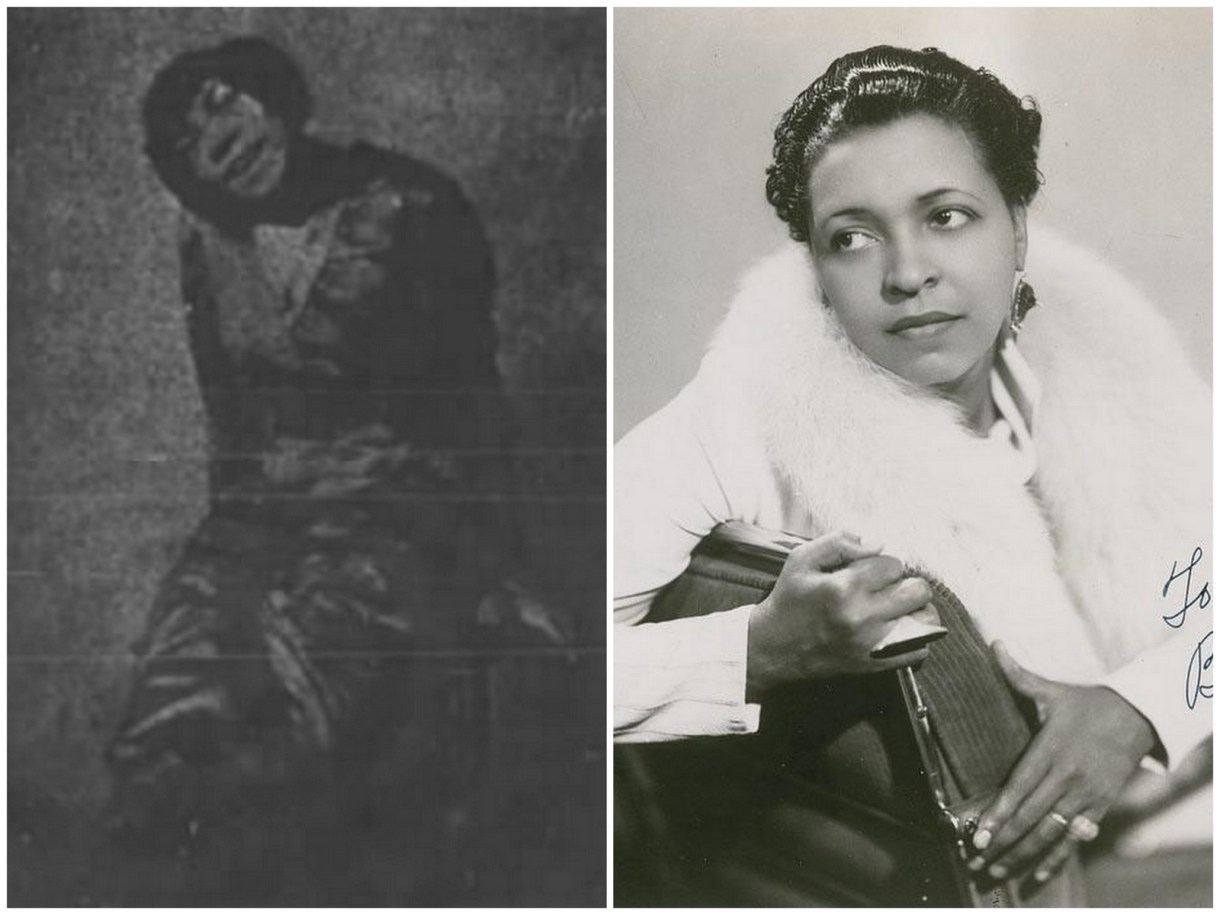
“The Two Ethels” met at the Alhambra Theater in Harlem — Ethel Waters was a popular blues singer and Ethel Williams was a dancer. They fell in love and summarily merged: Waters got Williams a job working at the cabaret where she worked, they lived together in Harlem and Waters took Williams with her on her first nationwide tour, where Williams would dance to warm up the crowd before Waters’ performances. In the touring revue Oh! Joy! they even did a little bit about being “partners” that winked at queer audience members while refusing mainstream identification. Waters’ managers at Black Swan Records manufactured gossip about Waters, once pushing a piece about how her recording contract stipulated that she couldn’t get married to explain her not having a male partner. Eventually, Ethel Williams left Waters and her job to marry a dancer named Clarence Dotson.
Florence Yoch and Lucile Council (1921-1964)

Considered “two of the finest garden designers and landscape architects in California,” Lucile started out as Florence’s “apprentice” at her firm and then became her “partner,” as you do. They designed estates, parks, movie sets and botanical gardens. Notable works include The Getty House gardens, the film sets for the exterior of “Tara” in Gone With the Wind and the estate of Howard Huntington. Their collected works are documented in the book Landscaping the American dream: the gardens and film sets of Florence Yoch, 1890-1972.
Dorothy Arzner and Marion Morgan (1927-1971)
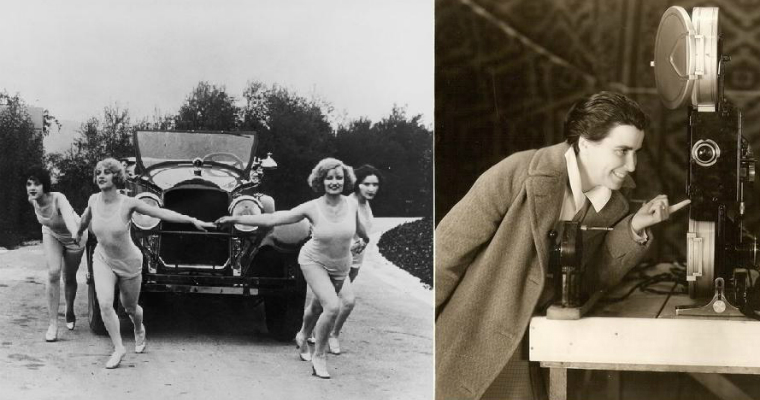
via Lesbian News
Arzner was the only successful female film director of Hollywood’s golden age, and she met her beloved Marion on the set of Fashions for Women. Marion Morgan was a vaudeville dancer and choreographer who led her own performance troupe. They began working together on films and in 1930 and commissioned architect W.C. Tanner to build them a Hollywood Hills estate — Florence Yoch designed the gardens. They lived there for 40 years, until Morgan’s death in 1971.
Mabel Hampton and Lilian Foster, 1932-1978
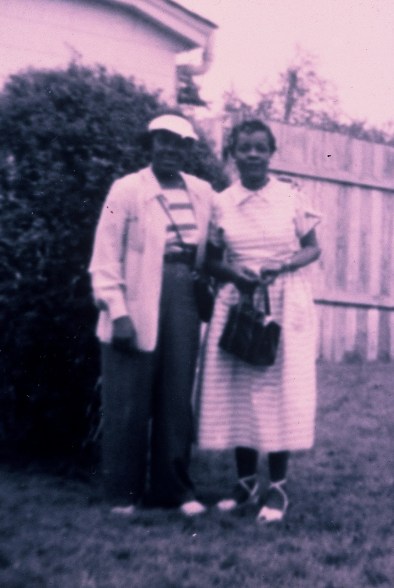
Mabel Hampton, born in 1902, had a tumultuous childhood that took her from North Carolina to New York City to New Jersey and eventually to a job dancing in Coney Island just as the Harlem Renaissance was in full swing. She performed with stars like Moms Mabley and Gladys Bently and lived openly as a lesbian, eventually giving up dancing and becoming a domestic worker — for the family of the now-famous Joan Nestle. She met Lillian Foster in 1932, and they were inseparable until Lilian’s death, living together on 169th street in the Bronx and calling each other husband and wife. They were active in the Gay Rights movement, ran their own laundering business, and worked together to collect and organize a wealth of documents, newspaper clippings, photographs and books, including programs from the opera performances she and Foster loved attending, that would help form the Lesbian Herstory Archives, of which Joan Nestle named Mabel a founding member. Mabel’s oral history was preserved by Joan in the archives.
Ruth Ellis and Ceceline “Babe” Franklin, 1936 – 1971
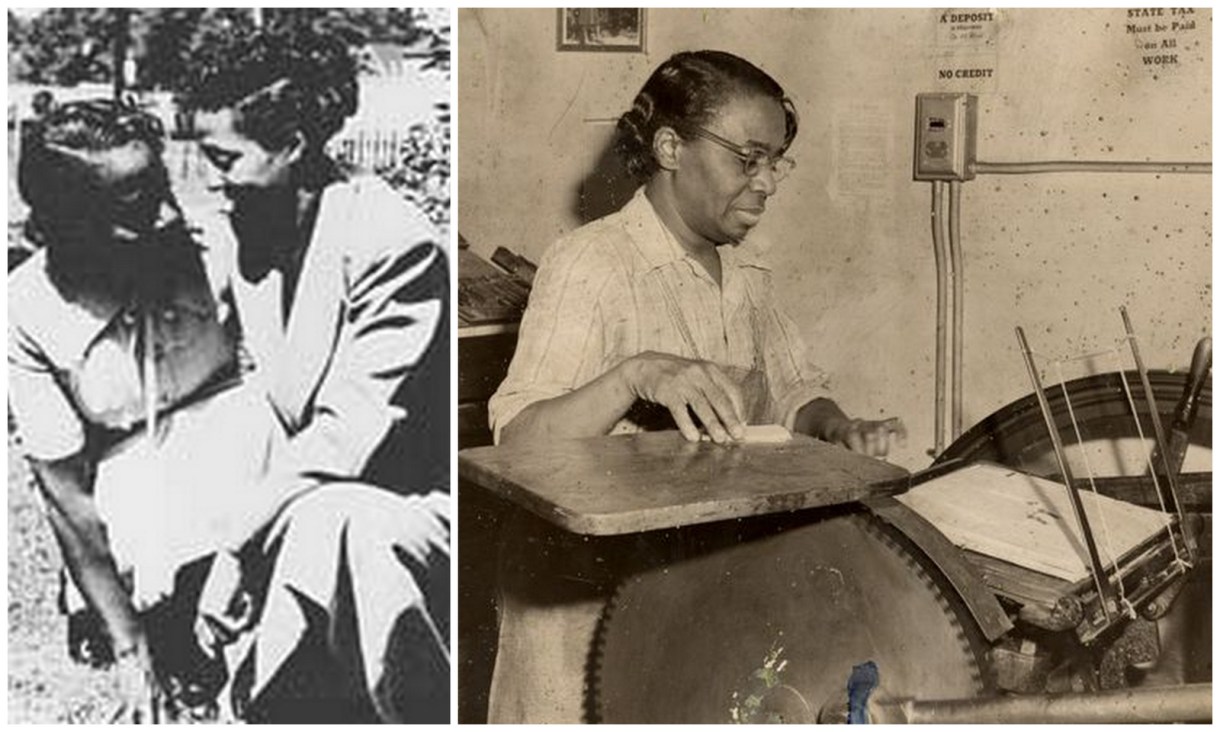
Ruth C. Ellis met Ceciline “Babe” Franklin in 1936, and then they moved to Detroit and launched Ellis and Franklin Printing, which made Ellis the first woman in the city to own her own printing business. Franklin worked as a chef. They bought a house in 1946 which became known as the “Gay Spot,” a gathering place for the local black gay and lesbian community. It was a welcome refuge for black folks who weren’t given access to the white bar scene. “Gay people didn’t have anyplace else to go,” Ellis said in Family: A Portrait of Gay and Lesbian America. “Everybody would bring a bottle. We used to dance a lot. We had a piano in the basement and we’d sing and play. We’d dance and drink and play cards.” They gave lodging to gay black men newly arrived from the south, and helped young folks through college. Since 1999, The Ruth Ellis Center in Detroit has been a place of refuge for homeless LGBTQ youth, so her incredible legacy lives on.
If you know of a lesbian couple who got together before 1940 and did cool shit, tell me about it in the comments!!!



What a gorgeous piece.
Awesome piece Riese! I actually wrote my undergraduate thesis on a similar topic last year! Here’s the link! Enjoy! https://www.dropbox.com/s/o4zwkvflr2dmoxe/Thesis.docx?dl=0
And no mention of Natalie Barney and Romaine Brooks. Fie!
Yep, sure was. The biggest lesbian power couple though was Susan B.Anthony and Elizabeth Cady Stanton.
Both were suffragettes who fought to get women the vote.
In the end I had read that they had been buried side by side.
Yeah you’re right Rous, I’d does seem to shed some much needed light on a lot of the great things lesbians did, not only for other lesbians…but society on the whole!
“Here are these two middle-aged lesbian artists hanging out on an island, and then here come the Nazis. And these two women, instead of just keeping their heads down or trying to rally the inhabitants of the island to revolt, they decide they’ll go after the Germans themselves. ”
–>!!!! https://theoffingmag.com/essay/claude-cahun/
WOW. Thanks for sharing this, I hadn’t heard of Claude and Marcel nor had I really heard of Gertrude Stein and her Nazi sympathizer-ness before either.
I was going to pitch them!
Yes! Terry Castle has a wonderful essay on these two!
Great piece, Riese. I always used to beam in classes when we discussed Jane Addams; the first modern social worker was a lesbian like me! Happy last day of Social Work Month, fellow queer social workers!
You know, it was never mentioned when I was in Social Work school, that she was a lesbian. We talked about her SO. MUCH. But that was always left out. Hmm.
Also, yay social workers!!! <3
i’m retroactively learning that everyone i loved in high school AP united states history was a lez and now i’m even more disappointed by the curriculum’s treatment of women. i didn’t know jane addams was gay until now despite spending WEEKS on her and the social movements of the time.
wahey! excellent stuff, thanks riese!
Rummy Ares
I vote to option all of these for movies
SO GOOOD, what a great piece! I also recommend looking up Tove Jansson and Tuulikki Pietila, artist power couple of Finland/France and creator/supporter of the internationally successful Moomin franchise. http://www.bbc.com/news/magazine-26529309
Yes!! I came to the comment section just to say this and was happy to see someone else already had.
!!!!!
So many women kids need to hear about in class and don’t, particularly annoying when we know of others who worked on similar stuff but not them because they’re gay(lgbt)women. Not sure if that’s true all over just my own experience of a non-diverse childhood in small town 90s England.
Amazing women all of them.
I have definite #relationshipgoals with some of them though, particularly the writers/illustrators. I’m a writer who loves an artist but she doesn’t know she’s an artist. She paints and makes beautiful pictures but she’s too self-conscious/busy with her day job to devote the time to the art it needs and to publicise it as anything not for her. Yes that’s her business but it makes me sad because the world’s missing out on her talent. It’d be a dream of mine to work on a collaborative book together.
I think I’ll bookmark this page so I can remember these women as I’m not great with learning names of new people and I really want to with these ones so I can find out more about them.
This was so great! The only couple I would insist on adding is Mary Woolley and Jeanette Marks, two truly badass lady-loving ladies who were pioneers of women’s education in the early 20th century. https://ascdc.mtholyoke.edu/exhibits/show/woolleymarks
LOL I just did the same thing I love you hannah ?
Seconded! There’s also a play about them going on at Lincoln Center in NYC (though I think it only got extended through the first weekend of April?) called “Bull in a China Shop” that’s about this couple.
love it! Can I add Pamela Mitford and Giuditta Tommasi? they were amazing and so badass as well <3
I will always be pissed on behalf of twelve year-old queer girl who thought she was the only freak in the whole world because history had been so straightwashed (and because Ann M. Martin couldn’t put a queer girl in the BSC, but I digress).
But yay for articles like this that heal the wounds!
The Edith and Violet example reminded me of a British lesbian couple in the Victorian era who wrote collectively under the pseudonym “Michael Field”: Katherine Bradley and Edith Cooper. They were also, uh, aunt and niece, and were obsessed with their dog named Chow.
http://thenewgay.net/2008/09/hidden-history-lesbians-of-michael.html
I was about to mention Michael Field! I am completely fascinated by them. Also Emma Donoghue wrote a book about them, so.
I wrote a paper on them in undergrad, attempting to prove that they were a couple in the modern sense. There’s ample historical evidence that their Boston Marriage was sexual in nature, especially the lesbian subtext in some of their plays, though we have to be VERY careful when looking at historical Boston Marriages to assume that they were sexual, rather than women who team up because they are uninterested in patriarchal norms.
This is rad, thanks Riese!
MARY WOOLLEY AND JEANETTE MARKS! So much info available via mount holyoke college archives! NYT Critics Pick at Lincoln center, Bull in a China Shop a brand new must see about these two!
UK power couples as above list very much of the US
Ladies of Llangollen, Lady Eleanor Butler and Miss Sarah Ponsonby, from 1780 – 1829. They became celebrated throughout the country as the story of their friendship spread through Regency Society.Also trailblazer in Garden design.
Sylvia Townsend Warner and Valentine Ackland 1930 – 1951 writer (STW) and poet (VA)
Vera Holme with Evelina Haverfield Suffergettes and founders of Orphanage inSerbia
Louisa Garrett Anderson and Flora Murray suffergettes and Doctors (both of them)
Also add Eva Gore-Booth and Esther Roper! Organisers for women’s suffrage among the Trades Unions in NW England.
The Ladies of Llangollen were also visited by authors such as Wordsworth, Shelly and Byron. They house and gardens are absolutely stunning and I highly recommend going to see them if ever in the area! My ex lived just outside Llangollen and we took it as an opportunity to pay our respects to these wonderful ladies who defied their families wishes.
WOMEN ARE POWERFUL!!!!!! When will men finally accept that as fact?
I’m convinced the ladies of Llangollen inspired the Northern Exposure episode about the founding of the town, Cicely.
Didn’t Carmen Rios write a piece kind of like this one a while ago? Is she still writing for AS? I miss her!
Great list! Another power couple: Mary Dreier and Frances Kellor.
You must add the author, Daphne Du Maurier, and her lover Gertrude Lawrence, an actress.
OMG I HAD NO IDEA THIS WAS A THING
Another option: E. Jane Gay and Alice C. Fletcher. Despite concerns over Fletcher’s involvement with the Dawes Act, they produced some amazing work together. https://iiif.lib.harvard.edu/manifests/view/drs:3463914$1i
Wonderful! Do you have a version with citations?
Oh don’t be greedy KateLynn, just be glad we got THIS much!
There was also Radclyffe Hall and Una Troubridge. Hall wrote “The Well of Loneliness,” which was one of the very first novels about a lesbian couple ever published, and it was banned for a strong forty years before it started being circulated again. Her family was well-acclaimed and very wealthy. The couple lived together from 1915 to the 1960’s.
Not to rain on the parade (I’m a bit of a Radclyffe Hall fan myself), but especially during these times, it should be mentioned that Troubridge and Hall were great fans and friends of Mussolini. There were quite a couple of lesbians who supported the fascists and nazis, not just some gay men :/
Well, “getting shit done” together could be positive or negative, depending on your political leanings, etc. ;)
Personally, while I would be frustrated with mainstream media representation that focused on the “negative” achievements, since there’s so little representation of any type (don’t just give us sad and angry gay villains), I don’t mind a discussion of the full gamut of folks here. People are complex.
I have a novel by Michael Baker.. good stuff.
Where can this book be found?
I wholeheartedly second Tove Jansson and Tuulikki Pietilä. I get that this list is US focused, but maybe they can be honorary members. Tuulikki Pietilä was born in Seattle, actually, so that almost counts?
They are my favorite.
What about this couple:
Felice Rahel Schragenheim (March 9, 1922 – December 31, 1944) was a Jewish resistance fighter during World War II. She is known for her tragic love story with Lilly Wust and death during a march from Gross-Rosen concentration camp (today Poland) to Bergen-Belsen concentration camp in Germany or, not later than, March 1945 in Bergen-Belsen.
Doctor Lilian Violet Cooper and Josephine Bedford – “lifelong companions” who came out to Australia together! Josephine was Lilian’s driver and head of the WWI ambulance service when they deployed to Serbia. Lilian was Queensland’s first female doctor.
http://www.yourbrisbanepastandpresent.com/2010/08/dr-lilian-cooper.html?m=1
http://adb.anu.edu.au/biography/cooper-lilian-violet-5770
Hi love it, worth looking at Dr Lillian Cooper and Mary Bedford…they started a hospital in Australia for women and Children. They also won bravery medals for humanitarian work in the first Serbian civil war..having bought an ambiance and evacuating injured where even mitary wouldn’t go..it was awarded by the then king of Serbia. They originated in England and ended their careers and lives in Australia. Fascinating story..even the fight to become the first female surgeon in the Southern hemisphere on Lillian part.Lillian was my great Aunt.
Lillian Smith and Paula Snelling… they ran a lot journal that collected critical views on the Old South and a girl’s summer camp. Lillian Smith was a well-known anti-racist advocate and writer in the South and she wrote the novel Strange Fruit.
Charlotte Perry and Portia Mansfield, the ‘mad women of Steamboat Springs’.
Virginia Woolf and Vita Sackville West from 1925 – 1929, not quite a power couple since they were both married to men, but it was an affair that produced some fabulous letters and one of the greatest novels in history – Orlando.
I second this so hard. I wrote my final paper on how their relationship produced that FANTASTIC and FASCINATING novel. I could go on for days.
End of 19th century Germany. Anita Augspurg and Sophia Goudstikker; Anita Augspurg and Lida Gustava Heymann. http://lesbischarchief.nl/personen/Anita_Augspurg.shtml Maybe you can translate from Dutch.
Martha van Rensselaer and Flora Rose
Another power couple: Longtime lesbian activists Phyllis Martin and Del Lyon. They spent 50 years fighting for justice and equality, opened the Lyon Martin Health Services for Women in San Francisco, which is still operating, a clinic driven by the idea that health care is a right. Mayor Gavin Newsom married them in 2008.
they didn’t start dating before 1940, which is the framework of this post
Alla Nazimova & Glesca Marshall ~ best parties in Hollywood!
Berlin’s out lesbians and resistance fighters Hilde Radusch and Else “Eddy” Klopsch. https://en.m.wikipedia.org/wiki/Hilde_Radusch#/editor/0
Why no mention of Natalie Barney and Romaine Brooks, surely, you know of them. When I travellwd to Paris in 2013 and 2014 I noticed many lesbians had plaques on their former residences except for the woman who ran a literary salon for 50 years, Natalie Barney. Romaine could only be found at the Musee Carnavalet. Natalie and Romaine were together for 50 years.
If I remember correctly from biographies, there used to be a plaque at Natalie’s Rue Jacob home in the 1970s. Not sure when it was removed though.
I second this. I always also felt that Brooks was completely underrated as an artist. Her stuff is amazing.
Geez, drop the negativity. Nobody here owes you anything.
thanks for introducing me to some fine women.
Thanks for this, Riese! Love it. So inspiring. I know you want to do articles featuring more diversity as you write more for this series but I was actually struck that four of these couples were black women. A badass group of babes. Whoa.
Lillian Smith had a lifelong relationship with Paula Snelling
Thank you for all of these fantastic women! So interesting, happy to have read this!!!!
“In 1893, two young nurses, Lillian D. Wald and Mary Brewster moved into a Lower East Side apartment to offer medical services to poor immigrants living in tenements nearby. Out of their initial effort grew two institutions, the Henry Street Settlement and its public nursing service, which later became the Visiting Nurse Service of New York. When Wald moved into 265 Henry Street in 1895, the city had a handful of settlement houses; by 1911 it would have at least 70. Wald became one of the nation’s most recognized social activists. Her urban nursing service helped create the field of public health nursing. Henry Street became a nerve center for causes ranging from labor arbitration to the abolition of child labor to racial integration and world disarmament (…) The activism of New York City’s settlement workers and visiting nurses thus helped to define social welfare and urban liberalism in 20th century America.”
“Wald never married. She maintained her closest relationships and attachments with women. Although she never self-identified as a lesbian, correspondence reveals that Wald felt intimate affection for at least two of her female companions.”
WOW my mother Berta Dean Dunn started the first Visiting Nurses Association in Mid-Missouri.
Eleanor Roosevelt & Lorena Hickock
Few American women have had the presence and effect on the world stage of Eleanor Roosevelt and, hopefully, we have grown to the point that we acknowledge that two people regardless of gender in a loving and supportive relationship only makes this world a better place for ALL.
Wonderful piece of herstory! Can’t wait for the next installment.
I’d love to add Charlotte Cushman and Emma Stebbins. Cushman was the pre-eminent actress in the middle of the 19th century and her wife Emma Stebbins designed the Bethesda fountain in NYC’s Central Park.
https://en.wikipedia.org/wiki/Emma_Stebbins
https://en.wikipedia.org/wiki/Charlotte_Cushman
They retired to Rome together, and created a small artists’ colony where they nurtured a large “family” of students and artists.
Ida Lupino directed 41 films and television shows in Hollywood, beginning in 1949.
Yeah, she did a lot alright, but I think she was a closeted lesbo (and married as well.
Still her contributions to lesbian history shouldn’t be overlooked.
I knew Ruth Ellis when I lived in Detroit, in the 1970s. She came to a senior program I ran at the Amalgamated Clothing & Textile Workers Union and I enjoyed her confidence and zip….by then she was a widow….and still out there, looking….. Another bell rang with Tracy Mygatt and Frances Witherspoon. In 1990 I was an archives asst at the Tamiment Library of radical history at NYU when I got an assignment to prepare papers of an organization that was counseling young men to request conscientious objection status to the World War I draft. Eventually the organization became the ACLU. Miss Frances Witherspoon was its secretary and she corresponded cordially with the lawyers and funders. Her typed & handwritten letters included references to Miss Mygatt and their vacations at Ogunquit in Maine. The language was always discrete and respectful but for me it didn’t take long to glean that Miss Witherspoon and Miss Mygatt were an item.
I knew Ruth Ellis when I lived in Detroit, in the 1970s. She came to a senior program I ran at the Amalgamated Clothing & Textile Workers Union and I enjoyed her confidence and zip…. by then she was already a widow….and still out there, looking….. I also have a connection with Tracy Mygatt and Frances Witherspoon. In 1990 when I was an archives asst at the Tamiment Library of radical history at NYU I took on a project to prepare papers of the lawyers organization that was counseling young men to request conscientious objection status to the World War I draft. This draft counseling group was a root organization of the ACLU. Miss Frances Witherspoon was its secretary and the primary writer of many of the letters that I was organizing. She corresponded cordially with lawyers and funders and there were often references to Miss Mygatt and their vacations at Ogunquit in Maine. The language was always discrete and respectful but I could tell fairly soon that Miss Witherspoon and Miss Mygatt were an item.
Please add Sophonisba Breckinridge and Marion Talbot! In addition to being two bad-ass pioneers in the field of education and social services, they were also involved in a juicy academic love triangle. Breckinridge was founded the University of Chicago’s School of Social Services. She earned a gazillion firsts: first graduate of the UoC Law School, first woman to earn a PhD in political science there, possibly the first person to teach a women’s studies course in the US, etc. Talbot was the University’s Dean of Women. There was a dramatic, multi-year love triangle between “Nisba,” Talbot, and the (also female) dean of the social services school. See: http://www.law.uchicago.edu/news/sophonisba-love-law-school-pioneer-and-women-who-vied-her-affection
Breckinridge and Talbot left such a mark on the University that they had dorms named after them. In fact, they were the ONLY student dorms on UChicago’s campus to be named after women — until recently, when they were renamed after rich donors. :(
Thanks for the shout-out for Sophonisba Breckinridge and her two loves, Marion Talbot and Edith Abbott! My (eventually) forthcoming biography from the University of Illinois Press will explore these relationships–and the amazing accomplishments they facilitated–in much more detail!
Great piece! I have another power couple for your consideration, Amaza Lee Meredith and
Dr. Edna Meade Colson.
Elsie de Wolfe, the first female professional interior decorator, had what was then called a “Boston marriage” with theatrical producer Bessie Marbury.
M. Carey Thomas and Mary Garrett were essentially the mothers of Bryn Mawr College (and Bryn Mawr High School and other incredible accomplishments). The two major biographies deny, but c’mon, read the love letters!
They also got the Johns Hopkins medical school to admit women on the same basis as men from Day 1 of the school. Gertrude Stein was in the first class of students (and left school in the middle of her senior year to be a writer instead).
In the hospital there’s still a sitting room for female students and faculty that’s named after Mary Garrett. It’s locked in case you need a nap in the middle of the day — or night.
Fantastic! Remember too Margaret Anderson and Jane Heap, editors of The Little Review in the 20s and 30s. They basically founded British and American Modernism!
There was a Unitarian woman from Philadelphia, Laura Matilda Towne, who answered the US Army’s call for educators for newly liberated former slaves on the Sea Islands near Beaufort, SC, and she and her partner Ellen Murray spent the rest of their lives there as teachers. The Unitarian Church in Beaufort has a partnership with the school, which still exists.
I’m currently working on a biography of social work educator and social justice activist Sophonisba Breckinridge, who had significant relationships with two women, Marion Talbot (Dean of Women at the University of Chicago), and Edith Abbott (Dean of the School of Social Service Administration at the University of Chicago). Her relationship with Talbot advanced women’s educational opportunities at the University of Chicago. Her relationship with Abbott helped both women establish the nation’s first graduate school of social work and have a profound influence on the U.S. welfare state during the New Deal. The book will be published by the University of Illinois Press; in the meantime, for more information, see http://mag.uchicago.edu/law-policy-society/entangled-lives.
Another great example is that of Communist couple Anna Rochester and Grace Hutchins! See https://www.amazon.com/dp/B00DBC3K74/ref=dp-kindle-redirect?_encoding=UTF8&btkr=1.
Thank you, Anya!
And very glad to hear you have a publisher for your biography of Breckenridge. I look forward to reading it!
See more about Anna Rochester and Grace Hutchins at http://www.passionatecommitments.com
Nominating Margaret Anderson and Jane Heap!
In 1916, Anderson met Jane Heap,[11] a spirited intellectual and artist immersed in the Chicago Arts and Crafts Movement, and a former lover to novelist Djuna Barnes. The two became lovers, and Anderson convinced her to become co-editor of The Little Review. Heap maintained a low profile, signing her contributions simply “jh”, but she had a major impact on the success of the journal through its bold and radical content.
For a while, Anderson and Heap published the magazine out of a ranch in Muir Woods, across the San Francisco Bay Area, before moving to New York’s Greenwich Village in 1917. With the help of critic Ezra Pound, who acted as her foreign editor in London, The Little Review published some of the most influential new writers in the English language, including Hart Crane, T. S. Eliot, Ernest Hemingway, James Joyce, Pound himself, and William Butler Yeats. The magazine’s most published poet was New York dadaist Baroness Elsa von Freytag-Loringhoven, with whom Heap became friends on the basis of their shared confrontational feminist and artistic agendas.[12] Other notable contributors included Sherwood Anderson, André Breton, Jean Cocteau, Malcolm Cowley, Marcel Duchamp, Ford Madox Ford, Emma Goldman, Vachel Lindsay, Amy Lowell, Francis Picabia, Carl Sandburg, Gertrude Stein, Wallace Stevens, Arthur Waley, and William Carlos Williams. Even so, however, she once published an issue with a dozen blank pages to protest the temporary lack of exciting new works.[13]
In 1918, starting with the March issue, The Little Review began serializing James Joyce’s Ulysses.[14] Over time the U.S. Post Office seized and burned four issues of the magazine, and Anderson and her companion and associate editor, Jane Heap, were convicted of obscenity charges.[15] Although the obscenity trial was ostensibly about Ulysses, Irene Gammel argues that The Little Review came under attack for its overall subversive tone and, in particular, its publication of Elsa von Freytag-Loringhoven’s sexually explicit poetry and outspoken defense of Joyce.[16] During the trial in February, 1921, hundreds of “Greenwich Villagers”, men and women, marched into Special Court Sessions;[17] eventually, Anderson and Heap were each fined $100 and fingerprinted.[18][19]
Sorry, forgot attribution, https://en.m.wikipedia.org/wiki/Margaret_C._Anderson
Great work Dyke warriors!
Tracy
Really, really heartened by all of the additions in these comments! #everyoneisgay
In 1940 Margaret Wise Brown, author of Goodnight Moon, began a long-term relationship with Blanche Oelrichs (former wife of John Barrymore), lasting until Oelrichs’ death. Both individuals were prolific in their own right, a bio of Brown (by Leonard S Marcus) suggested the relationship was stormy, not exactly a happy love story.
Here’s an interesting couple from 18th Century UK
The story of two aristocratic ladies who eloped together to Wales in 1778 and lived happily ever after in a cottage ornée, surrounded by gardens full of Gothic follies. Their names were Lady Eleanor Butler and Sarah Ponsonby, but they were better known as the Ladies of Llangollen, “the two most celebrated virgins in Europe”.
http://www.telegraph.co.uk/travel/destinations/europe/uk/wales/724170/Wales-A-tale-of-two-ladies-ahead-of-their-time.html
Del Martin and Patricia Lyon of Lyon Martin Clinic is SF.
What, no Willa Cather and Emily Lewis?
Cather “lived for 38 years in domestic partnership with Edith Lewis, a professional editor, in New York City. Lewis’s editorial skills probably contributed to Cather’s elegant prose style, as the two of them went over her novels together before publication.”
http://www.publishersweekly.com/pw/by-topic/industry-news/tip-sheet/article/56879-10-things-you-probably-didn-t-know-about-willa-cather.html
I was about to add her too. Willa Cather is my favorite author and I loved her even more when I learned she was lesbian.
Missing: Elisabeth Marbury (1st literary agent for playwrights) & Elsie De Wolfe (1st female interior decorator)! Total badasses!! Look ’em up.
Katharine Lee Bates and Katharine Conan.
En.wikipedia.org/wiki/Katharine_Lee_Bates
That’s Coman, not Conan. Damn autocorrect!
Frances Willard and Anna Gordon (1877-1898)
Willard was the big mover and shaker, best known as the founder and long-time president of the Women’s Christian Temperance Union, but she also was the first dean of women at Northwestern and a long-time campaigner for women’s suffrage and against domestic abuse.
Anna was her secretary and eventually moved in with her. After Frances died Anna basically continued their work, leading to the passage of the 18th Amendment. (I know, not the greatest achievement in the history of U.S. social reform in retrospect.) She also wrote Frances’ biography.
Here’s Frances’ statement on women’s friendships.
“The loves of women for each other grow more numerous each day, and I have pondered much why these things were. That so little should be said about them surprises me, for they are everywhere…. In these days when any capable and careful woman can honorably earn her own support, there is no village that has not its examples of ‘two hearts in counsel,’ both of which are feminine.”
excellent work, thanks Riese
Makes me proud to be an APlusser
Love this and the tone you set!
I stumbled on this on FB and really enjoyed it. It brought to mind a couple in my community who’ve been together around 50 years. They were both married, one couple had a boy and one had a girl. The kids grew up together as their parents were friends. The women divorced the men and moved in together, and ran a very successful ranch, far out in the country. K wore men’s western wear, ran the cattle, slaughtered chickens and turkeys for them and many neighbors; F wore dresses and kept a low profile. When their children grew up they married each other and had a baby, resulting in both their mothers being grandmother to their biological grandchild! They didn’t change the world, maybe, but they sure were a pillar of this community for a long time.
The is the really really realllllly awkward bit about Jane Addams being a proponent of eugenics and her being called mother of “social work”. Most people miss this tragically awful bit though. Supposedly she renounced this later? But that too is iffy…but ya know…
Interracial power couple Dr. Shi Meiyu (known as Mary Stone in the United States) and Jennie Hughes!
From “The Beautiful Country and the Middle Kingdom” by John Pomfret:
“In the 1910s, heated debates raged in the dormitories of Smith College and other women’s schools over who was the greatest living woman–Mary Stone of China or the social worker Jane Addams…
Jennie Hughes was a red-haired American beauty. She and Stone spent the next forty years together. They shared a bed, were apparently lovers, and, as “aunties”, raised five adopted children. Their relationship inspired admiration and the support of those around them, not least because Stone was clearly Hughes’s equal.’The harmony–may I not say Christian love–existing between Miss Hughes and Dr. Stone,’ wrote Stone’s benefactor, I.N. Danforth, ‘is something worth going a long way to see.’ To Stone, her relationship to Hughes was a microcosm of what a merging of American and China could be. The women called themselves ‘Gemini–the heavenly twins.’…
Stone was a crack fundraiser. On furloughs in America, she would wow Methodist churchgoers across the country with her voguish slang and progressive flair. ‘Kipling would not have sung ‘Oh East is East and West is West and never the twain shall meet’ had he know Dr. Mary Stone!’ wrote Mary Wilton [in July 1916]. ‘In her, East and West have met with peculiar power.’…
In 1920 they founded the Bethel Mission on the then radical principle of Chinese and American equality. The pair bought a ten-acre plot in Shanghai and built a high school, a three-story hospital, and a tabernacle.”
You should probably look at Willa Cather and Edith Lewis. Cather was a Pulitzer Proze winning novelist and Lewis was editor of McClures. Lots of people insist Cather was not a Lesbian but she sure had a plethora of girlfriends! She and Lewis lived together from 1908 till Cather’s death in 1947. Lewis became executor of Cather’s estate and they are buried next to one another, so, you do the math.
Hiya. You should check out the Ladies of Llangollen, who predate all these fine women, and ran a salon in the middle of nowhere in North Wales, to which notaries as high up as the Duke of Wellington journeyed. https://en.m.wikipedia.org/wiki/Ladies_of_Llangollen
Anne Lister and Ann Walker – early 1800’s. Lister was known in Halifax, UK as Gentleman Jack; she married Ann Walker some time after 1932, opened and owned a colliery and was the first person to climb at least one mountain in France. Her diaries were written in code and were only decoded in the 1980’s.
since you know anne lister i’m sure you heard this news but if not, HBO and BBC are making a miniseries about her: https://www.themarysue.com/shibden-hall-hbo-bbc/
Love this list, but what about bestselling British author Marie Corelli (she wrote the top-selling book of the 1890s, “The Sorrows of Satan”) and her longtime companion Bertha Vyver, who wrote Marie’s biography after she died? Lilian Faderman talks about them in “Surpassing the Love of Men.”
vita sackville-west and the eternal queen of my lez-lit-scholar heart, virginia woolf! virginia wrote a completely bonkers (in the best way) novel about a 400-year-old gender-bending time-traveler based on vita. that qualifies as getting shit done together, right? they also wrote some pretty lesbosexy love letters which are almost all collected in anthologies for your reading pleasure, like this truly amazing bush pun from virginia to vita circa 1927: “I feel like a moth about to settle in a sweet bush — would it were — ah, but that’s improper.”
i love them both so much i can’t even explain it
Edie Windsor and Thea Spyer
https://www.google.com/?gws_rd=ssl#q=Edie+windsor+thea+spyer&*&spf=386
https://www.nytimes.com/2016/09/30/fashion/weddings/edie-windsor-lgbt-activist-marriage.html?_r=0
Here is a link to another power couple, this time artists in Canada. Thanks for a great article!
https://en.m.wikipedia.org/wiki/Loring-Wyle_Parkette
Whzt aboit Aluce Austen, photographer from Staten Island? Not sure re her partner … Great article, thank you
eva gore-booth and esther roper, also both editors of Urania – a feminist periodical from 1916-1940 with lots of discussions about gender and sexuality (basically the UK’s first feminist queer zine AFAIK)
My great aunt and her partner would count under this:
https://en.wikipedia.org/wiki/Stell_Andersen
https://en.wikipedia.org/wiki/Esther_Morgan_McCullough
Great Great Aunt Stell was 6 feet tall. She and Esther lived in NYC together, and were friends with a lot of gay male couples in the literary and arts worlds.
Marguerite Bertsch, screen writer, producer, director. 1889-1967
is someone we need to learn more about.
we have a Facebook page for her, but still seek more information
Marguerite Yourcenar met her lifelong partner Grace Frick in 1939 in the USA
for easy reference please find her bio on Wikihttps://en.wikipedia.org/wiki/Marguerite_Yourcenar
It’s never been really “mainstream” but there is quite a bit of evidence that “Stagecoach” Mary (Mary Fields) and Mary Amadeus (a nun) had a long-term lesbian relationship in the 1880’s-90’s. They fought for each other, helping Fields get to be the first ever black woman with a mail run, and Mary Amadeus to become a mother superior.
Sylvia Beach and Adrienne Monier would be a good addition to this list. Read Beach’s memoir, Shakespeare and Company. They were friends of Stein-Toklas, and Beach kept her bookstore open practically until the last possible moment as the Nazis advanced on Paris. She boxed and hid the books to keep them from being burned. Monier had her own store and sold art books.
If you don’t mind going north of the border:
two famous Toronto sculptors: Frances Loring (1887–1968) and Florence Wyle (1881–1968)
Hi love it, worth looking at Dr Lillian Cooper and Mary Bedford…they started a hospital in Australia for women and Children. They also won bravery medals for humanitarian work in the first Serbian civil war..having bought an ambiance and evacuating injured where even mitary wouldn’t go..it was awarded by the then king of Serbia. They originated in England and ended their careers and lives in Australia. Fascinating story..even the fight to become the first female surgeon in the Southern hemisphere on Lillian part.
I was expecting to see musicians Tiny and Ruby, whose story was told in the film: “Tiny and Ruby: Hell-Diving Women.”
Sylvia Beach and Adrienne Monnier, from the twenties and WWII in Paris
For years I have thought Gay Braxton and Miss Mary Lee Griggs were Madison, WIsconsin’s lesbian power couple. Here is some of the little bit that is written about them –
Gay Braxton (1877-1962) was the first staff member of Neighborhood House, where she remained from 1921 until 1949. She was educated at Smith College in Northampton, Massachusetts, which produced many leaders in the settlement house movement. Braxton had a strong resume of settlement house work, including at the Chicago Commons. If Gay Braxton was the tough-love leader, Mary Lee Griggs was the gentle and kind nurturer. Braxton’s nephew recalls that she “was tougher than Mary Lee and not so warm, but her high competence, her absolute integrity, and her genuine dedication came to be valued. Braxton and Griggs were long-time friends and maintained a life-long relationship in Madison.
Mary Lee Griggs’ history with Neighborhood House has a little mystery in its beginning. She may have taken some convincing to accompany Braxton to Neighborhood House as she apparently had been offered a position in an Iowa settlement house just as Braxton was coming to Madison. But, as the story is told, she arrived with Braxton in the fall of 1921 and never left. Lending credence to the story is that Gay Braxton recalls Griggs starting out volunteering and Braxton’s February 1922 monthly report mentions Griggs helping with Neighborhood House and teaching at a local school.
Miss Griggs was the very first teacher I had when my mother sent me to “nursery school” over fifty years ago. She was a lovely, kind and gentle woman. I would love to have her as my first lesbian role model.
Marion Morgan & Dorothy Arzner only lived in there home in the Hollywood Hills until 1951.
You totally missed Wellesley College’s darlings, Katharine Lee Bates & Katharine Coman.
From Wikipedia:
“Bates lived in Wellesley with Katharine Coman, who was a history and political economy teacher and founder of the Wellesley College School Economics department. The pair lived together for twenty-five years until Coman’s death in 1915.[8] In 1922, Bates published Yellow Clover: A Book of Remembrance, a collection of poems written “to or about my Friend” Katharine Coman, some of which had been published in Coman’s lifetime.[9]
Some describe the couple as intimate lesbian partners,[10] citing as an example Bates’ 1891 letter to Coman: “It was never very possible to leave Wellesley [for good], because so many love-anchors held me there, and it seemed least of all possible when I had just found the long-desired way to your dearest heart…Of course I want to come to you, very much as I want to come to Heaven.”[11] Others contest the use of the term lesbian to describe such a “Boston marriage”. Writes one: “We cannot say with certainty what sexual connotations these relationships conveyed. We do know that these relationships were deeply intellectual; they fostered verbal and physical expressions of love.”
Selma Lagerlof, the first woman to win the Nobel Peace prize in literature…Swedish…had a woman companion
Margaret Mead and Ruth Benedict. Anthropologists.
New Zealanders:
Writer:Katherine Mansfield 1888-1923, her English “wife” Ida Baker (LM) 1888-1978.
Also nominating Vida Dutton Scudder and Florence Converse. They were friends of Ellen Gates Starr and of Anna Rochester and Grace Hutchins. Scudder helped to found the first College Settlement for Women on Rivington Street in NYC. She taught English at Wellesley. Converse was an editor for The Atlantic Monthly. Both wrote several books; Converse’s novel Diana Victrix is a fictionalized version of their relationship.
Not too long ago I learned about Sarah Scott and Barbara Montagu, two women who got together in 18th century England. Sarah was a writer who published novels and stories, always anonymously or under a man’s name. Her books were popular and some think her novels about independent women influenced Jane Austen. In 1762, she wrote a feminist utopian novel called Millenium Hall, about a group of women in southwest England who organize a supportive community where women of all classes work together to help each other survive. More importantly, she and “Lady Babs” did the best they could to create that community around them, “a world of independent-minded women, strong, self-sufficient, and resourceful.”
They worked to bring down class barriers by suggesting that upper class women could free themselves from dependence on men if they were willing to do “the work that makes one independent and useful even if it be the labor ordinarily assigned to lower classes.” For working class women the community offered classes in literacy and numbers, support through pregnancy and with childcare, and a place to stay if they were turned out by their families or those who employed them as servants. All in the 1700s—who knew?
Two women who were major early benefactors of the University of California, and natural history collectors. They were together 42 years.
http://bancroft.berkeley.edu/collections/gaybears/alexkel/
Very powerful to read and know that we stand on the shoulders of giants…
Marty Mann first woman and one of the key founding members of AA and Priscilla Peck art director of Vogue.
Oprah and Gale!!!!!!!!!!
How could you not include Natalie Barney and Romaine Brooks. Although they rarely lived together, Natalie was a prolific writer (mostly written in French) and Romaine was a portrait painter who mostly painted lesbians. Both drew inspiration from each other, though they were, socially, total opposites. Both gave money and help to other women who were down on their luck, such as Djuna Barnes, Dolly Wilde,Elisabeth Eyre Delanux, Elisabeth Gramont.
This article has encouraged me to think about all the lesbian couples — present and past — in religious history, specifically my own group. the Episcopal Church. Two women that came to mind immediately as a generative partnership were Vida Scutter (Christian socialist, activist, mystic) and Florence Converse (activist and writer.)
Clara Spence and Charlotte Baker who ran the Spence School in New York City to educate girls!
The couple known as The Ladies of Llangollen were a Welsh couple who lived in the 19th-early 20th century and ran an estate (now a museum) that was a haven of the arts